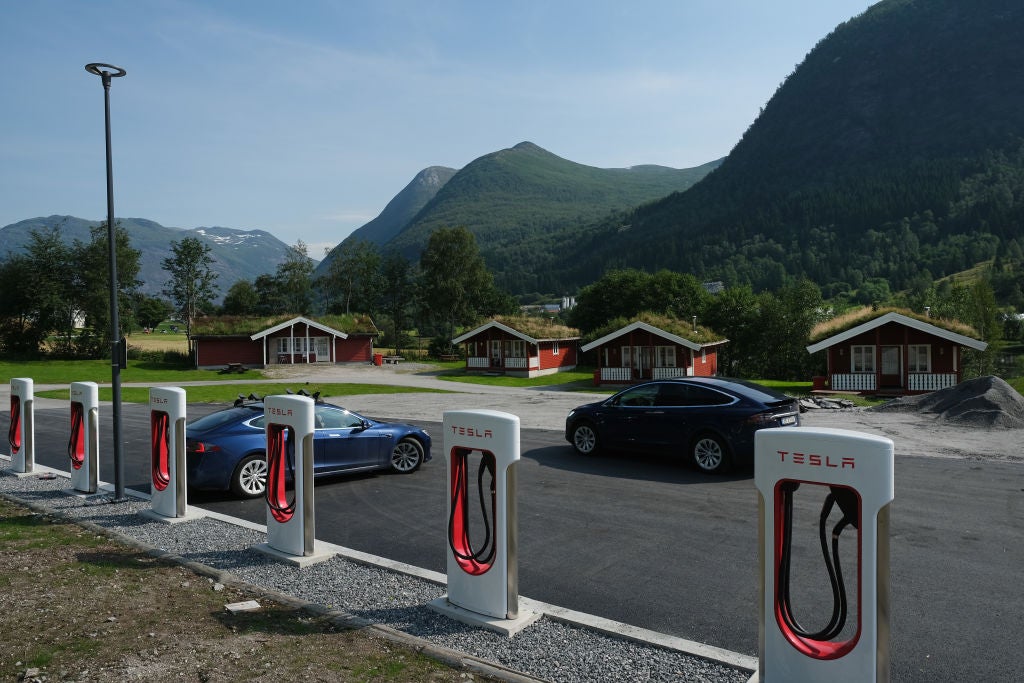Norway is streets ahead of the rest of Europe when it comes to electric vehicles (EVs). Over the course of 2021, 65% of new car registrations in the country were all-electric battery electric vehicles (BEVs) and 28% were hybrids (22% plug-in hybrid, 6% non-plug hybrid), shows data from OFV, the Norwegian Road Traffic Information Council, which has been collated by Robbie Andrew from the CICERO Center for International Climate Research in Oslo.
The figures for 2021 represent massive growth in the country’s EV market. In 2018, 31% of cars sold were BEVs, increasing to 42% the following year, and 54% in 2020. The Norwegian government has a goal that all new cars will be BEVs by 2025. An analysis by the Norwegian Automobile Federation’s magazine, Motor, suggests the upward trend has been so steep that the last non-BEV or hybrid car sale in Norway could be as early as April 2022.

Discover B2B Marketing That Performs
Combine business intelligence and editorial excellence to reach engaged professionals across 36 leading media platforms.

Rapid changes in the Norwegian car market provide a glimmer of hope for a rapid energy transition to net zero. The net-zero pathway from the International Energy Agency (IEA), published in May 2021, suggests that by 2030, 60% of new car sales should be BEVs – a milestone Norway has already passed.
The growth in Norway’s EV market is the result of a series of wide-ranging policies that have transformed the traditional perceptions of EVs as too expensive, or lacking in range. Andrew highlights more than a dozen different taxes, subsidies and regulations that have a bearing on the country’s automobile market, including VAT exemptions for BEVs, one-off registration taxes that increase if a car has more emissions, lower annual ownership taxes for BEVs, exemptions from road tolls and reduced ferry toll rates for BEVs, differentiated parking fees, significant public investment in charging networks, and bus lanes opening up to BEVs.
So, instead of only subsidising the purchase of new electric vehicles, there is a whole framework in place to actually put consumers off petrol or diesel vehicles. This has been so successful the country’s former centre-right government (replaced by a minority left-wing administration in October 2021) estimated there is now a 19.2bn Norwegian krone (US$2.3bn) hole in the country’s annual tax revenue.
For the time being, no other country in Europe is matching Norway’s EV progress. In 2020, the year that Norway recorded 54% BEVs among new vehicles registered, the next largest BEV markets were Iceland at 26%, the Netherlands at 23% and Switzerland at 18%.

US Tariffs are shifting - will you react or anticipate?
Don’t let policy changes catch you off guard. Stay proactive with real-time data and expert analysis.
By GlobalData“Norway is certainly leading, and the government’s incentives are a big part of that,” says Andrew. However, he adds that other European markets are starting to follow the same curve. Indeed, in Europe as a whole, the uptake of hybrid and BEVs is beginning to increase rapidly, shows data from the European Environment Agency. The BEV and hybrid share of total registrations across the continent increased from 3.5% in 2019 to 11% in 2020 – or 550,000 to 1,325,000 units.
The impact of EVs’ increasing share of Norway’s car market will take some time to trickle down to the overall fleet of cars on the country’s roads. As of 2020, Norway’s fleet stood at 16% BEV and 6% hybrid. Given Norway generates more than 90% of its electricity from hydroelectric dams, this will be beginning to make a difference to the country’s overall emissions, which fell from 46 to 43 megatonnes of CO2 between 2010 and 2019.
Data from BP also shows Norway’s domestic oil demand decreased by an average of 3% each year between 2010 and 2020 – although biofuel sales roughly tripling in recent years will also have had a significant effect, in addition to the steady climb of EVs.





